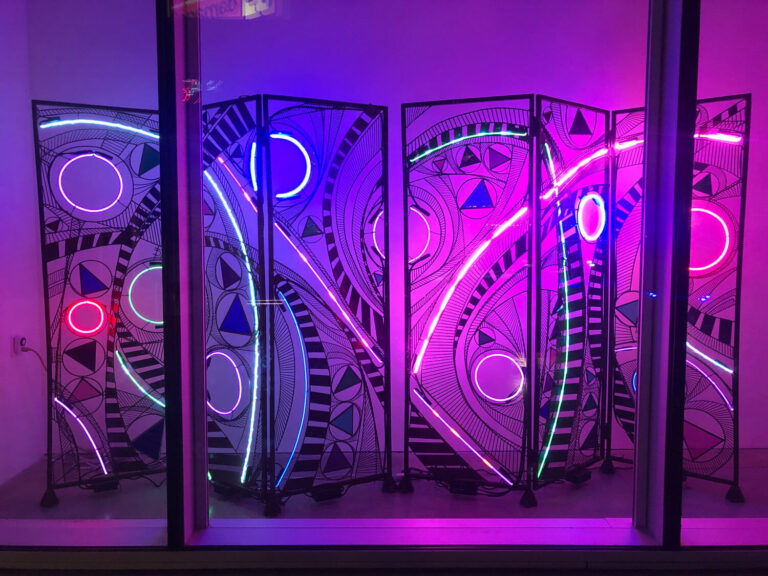
June 15, 2021- January 21, 2022
A window-based exhibition of handcrafted metalwork, stained glass, and neon sculptural work by Tessie Dong.Artist Tessie Dong and the Museum of Neon Art were planning to display the artist’s monumental and delicate work in summer of 2020. Due to the pandemic, the exhibition of work by the 87-year-old artist was postponed until now, when visitors can enjoy the delicately handcrafted screen for free from the windows. Tessie Dong has been an artist all her life. “I’ve wanted to be an artist since I was in the first grade in China,” states Dong. Since the 1970’s Tessie Dong has created multimedia artworks ranging in scale from a few inches to up to 40 feet with materials such as steel rods, patinated sheet metal, paint, stained glass, textile, and neon. Tessie states, “I was working for a lot of banks creating woven pieces that were 40 feet long.To add dimension I proposed creating a welded metal structure to an architect with lace like metal and they approved it, when I got home I thought- what have I done? I realized I had to teach myself how to weld so I bought a welder and got to work.” Through her work in metalwork and neon, Dong creates elegant and rhythmic compositions that play with weight, delicacy, and light. The screen and chair that are displayed in the Museum of Neon Art’s windows are composed of undulating curves and circles that unify but also complicate the composition that contains stained glass, hand bent, and blown neon glass.
Tessie Dong was born in Canton, China. She moved to Arizona as a teenager and received an Associates of Art from Eastern Arizona College and later moved to Los Angeles for further study. She received her education at Art Center College of Design, specializing in commercial illustration. After photography grew in prominence as an advertising medium, Dong pivoted from illustrator to work in architectural model building. This attention to space and proximity to architects led her to propose monumental works, designed with architecture in mind. She conceived of and created large-scale architectural installations for banks, restaurants, tennis clubs, private homes and synagogues. The mediums she used ranged from batik canvases, painted dimensional murals, and multimedia sculptures. She is a skillful welder and glassblower who hand makes each element in her work, embracing the transformative capacities of color, light, and material. “I had to learn how to bend neon tubes in order to add them to my metal work so it’s integrated in the whole,” states Dong. Dong’s 20-foot tower Enlightenment is permanently installed at the Chinatown branch of the LA Public Library.
The second degree black belt in Shotokan Karate, avid gardener, and artist states “I keep on going.” Several years ago Tessie Dong was offered a large art commision the same week that she was diagnosed with cancer. The artist pushed through with the commission, secretly battling her diagnosis through studio sessions, chemotherapy, radiation, and naps. Every day she would move towards completing the work, promising herself she would not die before it was finished. “I almost died of cancer, but designing and completing my 24′ x 6’ x 2’ wall sculpture helped me to survive,” states Dong. The artist has been cancer free since.
Dong states, “My work is about interplay of space and form, of natural lines and industrial materials, of harmony and tension- it’s sometimes hard to delineate where my pieces start and stop and where work and life intersect. There is nothing about my world that is not part of a vast composition: My garden, my house, my studio, my life. They reflect the same symbiosis of organic chance and composition which typifies my evolving work.” Tessie Dong’s work has been exhibited internationally and she has participated in several museum exhibitions. Her work is held in various private and corporate collections.
“My art is a continual process. My goal is to design and create multi-media works for public and private spaces to enhance human communication through artistic media. I grow with each project and then apply my extended experience to each future work,” says Dong.
“Tessie Dong’s work bursts with vitality and elegance. Though she often uses industrial materials, she subverts expectations of the materials she uses. We waited a year to share Tessie’s work and it was well worth the wait,” states MONA Executive Director Corrie Siegel.
Though the work can be seen and appreciated all day long, the best time to see it is at dusk or after nightfall. The exhibition will be on view until December of 2021.
